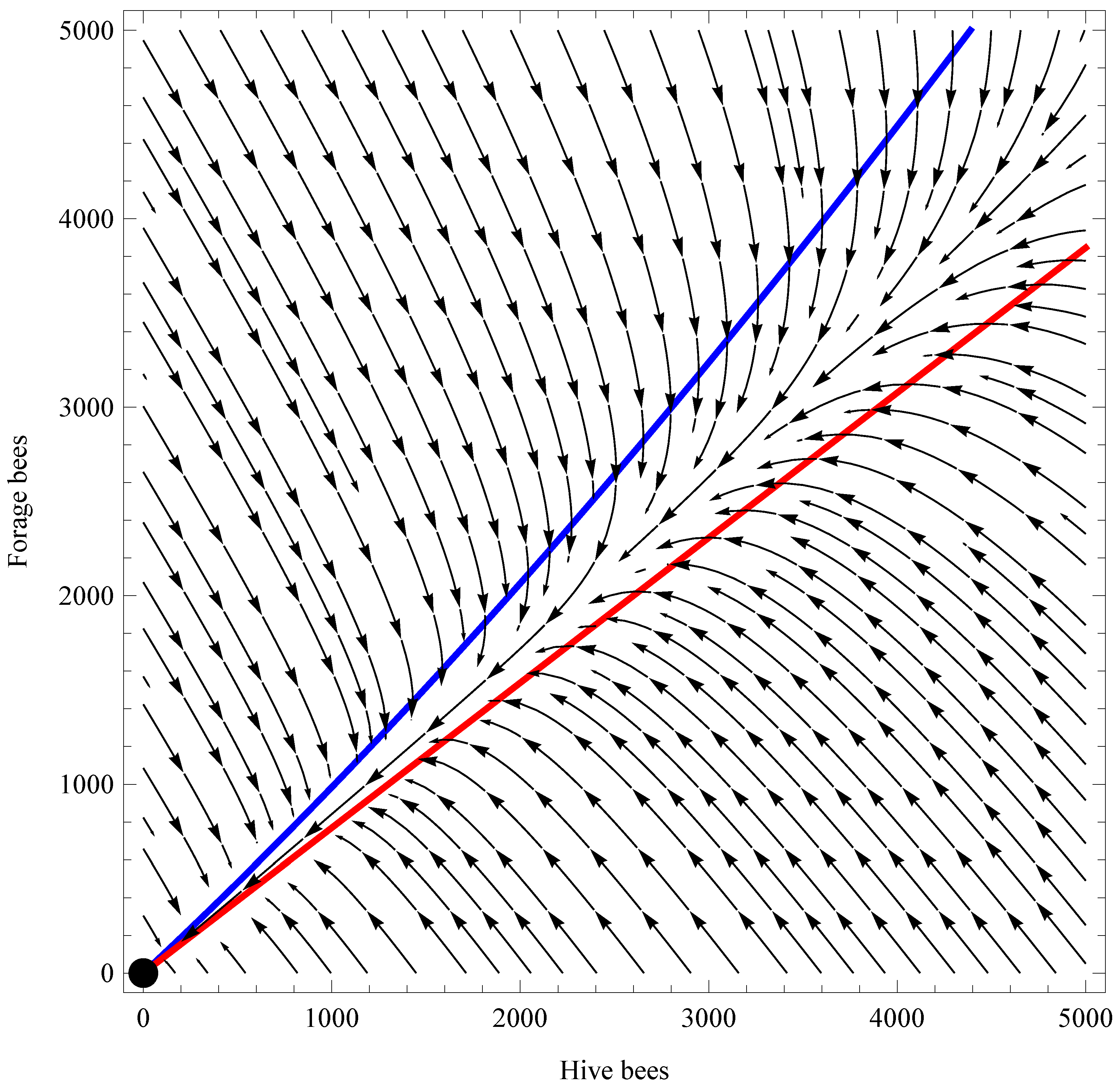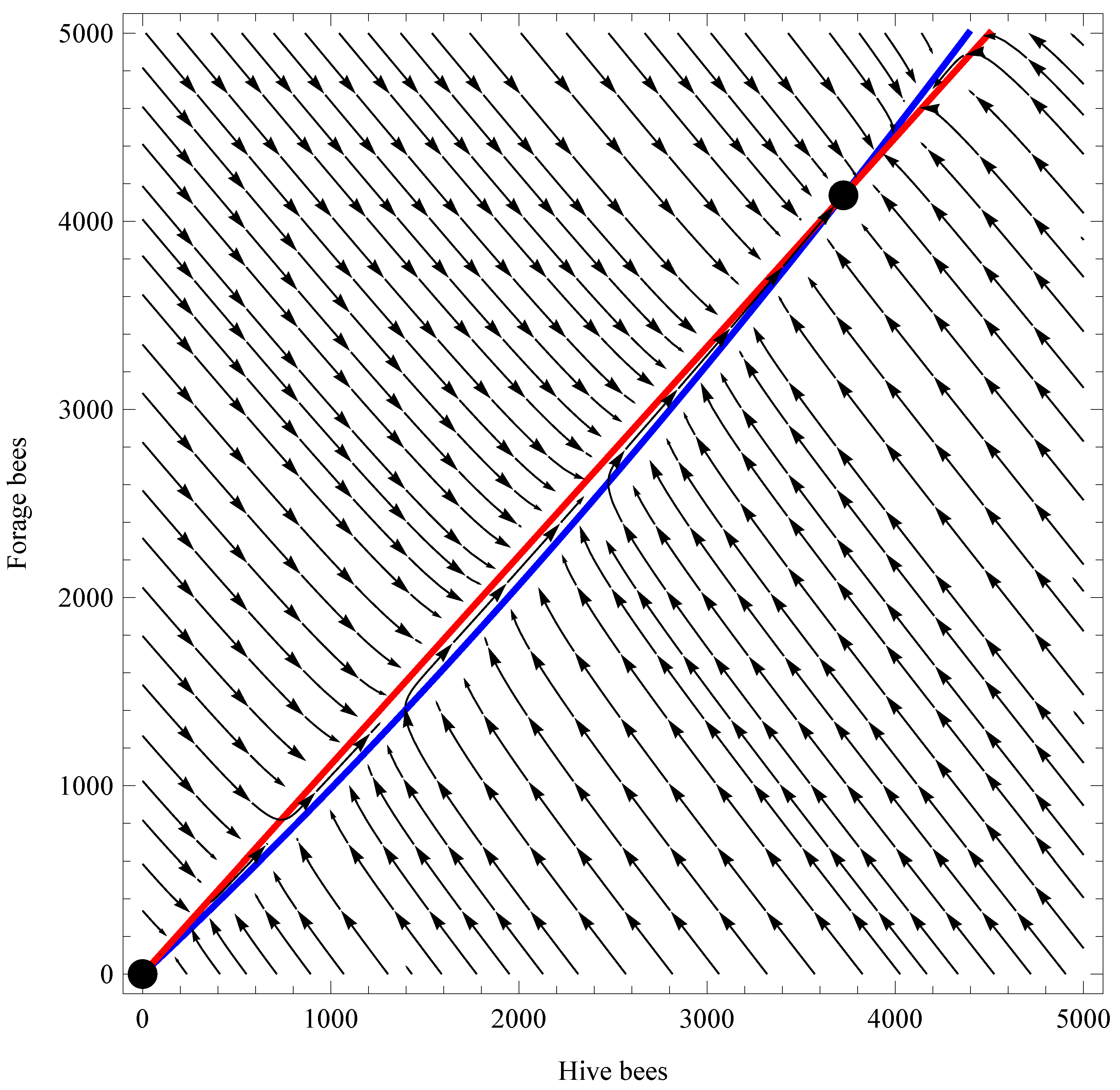Threshold Dynamics of Honey Bee Colonies with General Eclosion and Social Inhibition
Abstract
1. Introduction
- (C1)
- with , , and for .
- (C2)
- with , and for .
2. Results
2.1. Positiveness and Ultimate Boundedness
2.2. Basic Reproduction Number
2.3. Stability of Trivial Equilibrium
2.4. Uniform Persistence
- (a)
- If , and , then M has a positive eigenvalue with a positive left eigenvector , where and .
- (b)
- If , and , then M has a positive eigenvalue with a left eigenvector , where and .
- (c)
- If , , , and , then and M has two simple eigenvalues and satisfying . Moreover, the left eigenvector associated with can be chosen as with and .
2.5. Positive Equilibrium
3. Applications
- (a)
- If , then decreases with α. If , then increases with α. If , then is independent of α.
- (b)
- If , then increases with c. If , then decreases with c. If , then is independent of c.
- (c)
- As m increases, decreases.
- (d)
- Denote . If , then increases with β. If , then decreases with β. If , then is independent of β.
4. Conclusions
5. Discussion
Author Contributions
Funding
Institutional Review Board Statement
Informed Consent Statement
Data Availability Statement
Acknowledgments
Conflicts of Interest
References
- Evans, J.D.; Spivak, M. Socialized medicine: Individual and communal disease barriers in honey bees. J. Invertebr. Pathol. 2010, 103, S62–S72. [Google Scholar] [CrossRef]
- Ratnieks, F.L.W.; Carreck, N.L. Clarity on honey bee collapse? Science 2010, 327, 152–153. [Google Scholar] [CrossRef]
- Torres, D.J.; Ricoy, U.M.; Roybal, S. Modeling honey bee populations. PLoS ONE 2015, 10, e0130966. [Google Scholar] [CrossRef]
- Chen, J.; DeGrandi-Hoffman, G.; Ratti, V.; Kang, Y. Review on mathematical modeling of honeybee population dynamics. Math. Biosci. Eng. 2021, 18, 9606–9650. [Google Scholar] [CrossRef]
- USDA National Agricultural Statistics Service. Honey; USDA Economics, Statistics and Market Information System, Cornell University: Ithaca, NY, USA, 2025; Available online: https://usda.library.cornell.edu/concern/publications/hd76s004z (accessed on 12 September 2025).
- Russell, S.; Barron, A.B.; Harris, D. Dynamic modelling of honey bee (Apis mellifera) colony growth and failure. Ecol. Model. 2013, 265, 158–169. [Google Scholar] [CrossRef]
- Khoury, D.S.; Barron, A.B.; Myerscough, M.R. Modelling food and population dynamics in honey bee colonies. PLoS ONE 2013, 8, e59084. [Google Scholar] [CrossRef] [PubMed]
- Romero-Leiton, J.P.; Gutierrez, A.; Benavides, I.F.; Molina, O.E.; Pulgarín, A. An approach to the modeling of honey bee colonies. Web Ecol. 2022, 22, 7–19. [Google Scholar] [CrossRef]
- Amdam, G.V.; Omholt, S.W. The hive bee to forager transition in honeybee colonies: The double repressor hypothesis. J. Theor. Biol. 2003, 223, 451–464. [Google Scholar] [CrossRef]
- Huang, Z.; Robinson, G. Regulation of honey bee division of labor by colony age demography. Behav. Ecol. Sociobiol. 1996, 39, 147–158. [Google Scholar] [CrossRef]
- Varga, R.S. Matrix Iterative Analysis; Prentice-Hall: Englewood Cliffs, NJ, USA, 1962. [Google Scholar]
- Diekmann, O.; Heesterbeek, J.A.P.; Metz, J.A.J. On the definition and the computation of the basic reproduction ratio R0 in models for infectious diseases in heterogeneous populations. J. Math. Biol. 1990, 28, 365–382. [Google Scholar]
- van den Driessche, P.; Watmough, J. Reproduction numbers and sub-threshold endemic equilibria for compartmental models of disease transmission. Math. Biosci. 2002, 180, 29–48. [Google Scholar] [CrossRef]
- Mahbuba, J.E.; Wang, X.-S. Stability analysis of biological systems under threshold conditions. Symmetry 2025, 17, 1193. [Google Scholar] [CrossRef]
- Hale, J.K. Asymptotic Behavior of Dissipative Systems; American Mathematical Society: Providence, RI, USA, 1988. [Google Scholar]
- Smith, H.L.; Zhao, X.-Q. Robust persistence for semidynamical systems. Nonlinear Anal. 2001, 47, 6169–6179. [Google Scholar] [CrossRef]
- Magal, P.; Zhao, X.-Q. Global attractors and steady states for uniformly persistent dynamical systems. SIAM J. Math. Anal. 2005, 37, 251–275. [Google Scholar] [CrossRef]
- Hirsch, M.W. The dynamical systems approach to differential equations. Bull. Amer. Math. Soc. 1984, 11, 1–64. [Google Scholar] [CrossRef]
- Khoury, D.S.; Myerscough, M.R.; Barron, A.B. A quantitative model of honey bee colony population dynamics. PLoS ONE 2011, 6, e18491. [Google Scholar] [CrossRef] [PubMed]
- Booton, R.D.; Iwasa, Y.; Marshall, J.A.R.; Childs, D.Z. Stress-mediated Allee effects can cause the sudden collapse of honey bee colonies. J. Theor. Biol. 2017, 420, 213–219. [Google Scholar] [CrossRef] [PubMed]
- Elzinga, D.C.; Strickland, W.C. Generalized stressors on hive and forager bee colonies. Bull. Math. Biol. 2023, 85, 112. [Google Scholar] [CrossRef]
- Dennis, B.; Kemp, W.P. How hives collapse: Allee effects, ecological resilience, and the honey bee. PLoS ONE 2016, 11, e0150055. [Google Scholar]
- Britton, N.F.; White, K.A.J. The effect of covert and overt infections on disease dynamics in honey-bee colonies. Bull. Math. Biol. 2021, 83, 67. [Google Scholar] [CrossRef]
- Eberl, H.J.; Frederick, M.R.; Kevan, P.G. Importance of brood maintenance terms in simple models of the honeybee—Varroa destructor—Acute bee paralysis virus complex. Electron. J. Differ. Equ. 2010, 19, 85–98. [Google Scholar]
- Dynes, T.L.; Berry, J.A.; Delaplane, K.S.; Brosi, B.J.; de Roode, J.C. A model of infection in honeybee colonies with social immunity. PLoS ONE 2021, 16, e0247294. [Google Scholar]


Disclaimer/Publisher’s Note: The statements, opinions and data contained in all publications are solely those of the individual author(s) and contributor(s) and not of MDPI and/or the editor(s). MDPI and/or the editor(s) disclaim responsibility for any injury to people or property resulting from any ideas, methods, instructions or products referred to in the content. |
© 2025 by the authors. Licensee MDPI, Basel, Switzerland. This article is an open access article distributed under the terms and conditions of the Creative Commons Attribution (CC BY) license (https://creativecommons.org/licenses/by/4.0/).
Share and Cite
Rahaman, M.M.; Wang, X.-S. Threshold Dynamics of Honey Bee Colonies with General Eclosion and Social Inhibition. Axioms 2025, 14, 773. https://doi.org/10.3390/axioms14100773
Rahaman MM, Wang X-S. Threshold Dynamics of Honey Bee Colonies with General Eclosion and Social Inhibition. Axioms. 2025; 14(10):773. https://doi.org/10.3390/axioms14100773
Chicago/Turabian StyleRahaman, Md Mostafizur, and Xiang-Sheng Wang. 2025. "Threshold Dynamics of Honey Bee Colonies with General Eclosion and Social Inhibition" Axioms 14, no. 10: 773. https://doi.org/10.3390/axioms14100773
APA StyleRahaman, M. M., & Wang, X.-S. (2025). Threshold Dynamics of Honey Bee Colonies with General Eclosion and Social Inhibition. Axioms, 14(10), 773. https://doi.org/10.3390/axioms14100773







